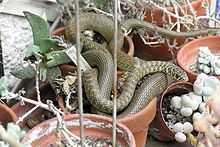Green whip snake
| Green whip snake | |
|---|---|
 | |
| Conservation status | |
| Scientific classification | |
| Kingdom: | Animalia |
| Phylum: | Chordata |
| Class: | Reptilia |
| Order: | Squamata |
| Family: | Colubridae |
| Genus: | Hierophis |
| Species: | H. viridiflavus |
| Binomial name | |
| Hierophis viridiflavus (Lacépède, 1789) | |
| Synonyms | |
|
Coluber gyarosensis Mertens, 1968 | |
The green whip snake or western whip snake (Hierophis viridiflavus) is a species of snake in the Colubridae family. There is a larger, often pure black variant found in Italy and referred to there as 'Il Biacco'.
Description
The green whip snake is a slender species with a small but well-defined head, prominent eyes with circular pupils, and smooth scales. The background colour is greenish-yellow but this is mostly obscured by heavy, somewhat irregular bands of dark green or black, particularly in the front half of the snake. The underparts are grey or yellowish and the tail has narrow longitudinal stripes. In the northeastern part of its range, in Sicily and southern Italy, most individuals are blackish in colour. The young are a greyish colour and develop their full adult colouring by about their fourth year. This snake grows to a total length of about 150 cm (59 in).[2]
Geographic range
It is found in Andorra, Croatia, France, Greece, Italy, Malta, Slovenia, Spain, Switzerland, and possibly Luxembourg.[1]
Habitat
Its natural habitats are temperate forests, temperate shrubland, Mediterranean-type shrubby vegetation, arable land, pastureland, plantations, rural gardens, and urban areas.[1]
Status
The green whip snake has a wide distribution and is very common within that range. The population is steady and faces no significant threats, apart from road kill and persecution, and the International Union for Conservation of Nature has assessed its conservation status as being of "least concern".[1]
Venom and toxicity
Commonly regarded as non-venomous, it is described that a subject who endured 'sustained biting' of up to 5 minutes began showing suspect symptoms, including problems with neuromotor skills.[3] It is described that a gland called the Duvernoy's gland, maybe similar to the venom gland, has some responsibility.
References
- ↑ 1.0 1.1 1.2 1.3 Milan Vogrin, Claudia Corti, Valentin Pérez Mellado, Paulo Sá-Sousa, Marc Cheylan, Juan M. Pleguezuelos, Andreas Meyer, Benedikt Schmidt, Roberto Sindaco, Antonio Romano, Iñigo Martínez-Solano (2008). "Hierophis viridiflavus". IUCN Red List of Threatened Species. Version 2013.2. International Union for Conservation of Nature. Retrieved 2014-09-28.
- ↑ Arnold, E. Nicholas; Ovenden, Denys W. (2002). Field Guide: Reptiles & Amphibians of Britain & Europe. Collins & Co. p. 207. ISBN 9780002199643.
- ↑ Some seemingly harmless snakes possess a secret venomous gland par Rachel Nuwer, smithsonianmag.com. October 18, 2013.
| Wikimedia Commons has media related to Hierophis viridiflavus. |
